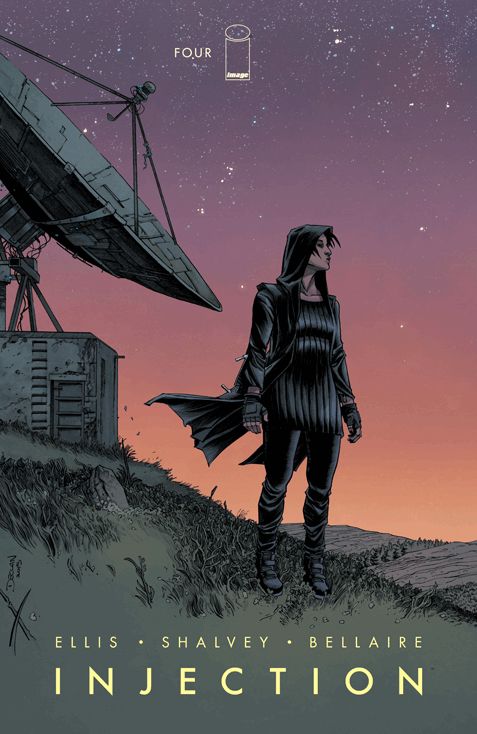Warren Ellis and Declan Shalvey's "Injection" #4 is much like its predecessors, which is to say that it is both marvelous and vexing due to Ellis' insistence on not showing the reader his full deck of world-building cards. In Ellis' recent work, from "Trees" to "Supreme Blue Rose" to "Moon Knight," mysticism and metaphysics shape a plot in which extraordinary events collide with a cast of unusual, vivid characters. The themes of 1980s-era Vertigo are back, but elaborated and subverted by Ellis' combination of sincere fascination and mocking irony.
For sheer comprehensibility, I prefer Ellis' more straightforward, conventionally structured stories, like the detective and killer faceoff in his novel "Gun Machine" or the gonzo journalism and cultural criticism of "Transmetropolitan." However, the opacity of "Injection" has its upsides. The storytelling structure produces a bouquet of surprises in each issue, and each new flowering of weirdness fits into the whole and brings forth new fruit. It doesn't feel like Ellis is making anything up as he goes along. The action always adds startling, brilliant details to the texture of the world, providing spectacular challenges and opportunities for the artist in every issue.
Shalvey's unusual line has a chalk-like but precise quality that adds starkness to every encounter and setting. While Ellis has also paired well with dreamier artistic styles like Tula Lotay's work, Shalvey's sharpness throws Ellis' verbal edges into greater relief. Ellis' prose shows a love of wordplay and diction that is almost incorrigible, like Matt Fraction's word choices and rhythms in his run on "Hawkeye." Jokes about "having a good cry" or "this is my TED Talk" fit in well and lighten the mood, but the laughter feels always quite close to tears. Shalvey successfully expands this brand of humor particularly well in the scene in which Maria's eyes bug with mania when she talks about a "best cast scenario." This suggested emotional strain and the hidden horror of the past and future give "Injection" a taut, hysterical atmosphere unlike anything else on the shelves.
Shalvey's panel compositions hum with linear detail in the opening panel progression and, in the middle of the issue, there's a beautifully eerie double-page spread filled with swirling foliage. Bellaire's monotones flatten too much space and detail for the forest setting and a clock-filled wall in another background. On the other hand, however, Bellaire's deliberate paling of color when the new Dispatch is debriefed is very effective in quieting down the action so that Ellis' voiceover can dominate. It also provides a crescendo-like lead-up to the final page, when full color intensity snaps back for a culmination that feels musical.
The final page is a tour-de-force. Shalvey creates a paradoxical effect, drawing beautiful, intricate architectural detail for an ugly building. The page howls, even though it's technically a silent scene. Shalvey's subdued body language and dramatic composition amplify the sad, creepy final line of dialogue. Bellaire's desolate palette of metal gray and rust red is a pitch perfect match to reinforce a mood of despair and decay. The implied horror haunts the reader. In an instant, Maria's characterization twists and deepens. A chill wind blows through the door of the past and suddenly the reader sees her head-on. Formerly an amusing eccentric or grumpy madwoman, Maria suddenly rivets the reader's attention as the last line suggests desperation, weary resignation and a soul pushed long past its limits in search of an absolution that will always elude her.
"Injection" #4 isn't easy reading and some of the scenes drag a little with exposition, but the frustrations of the storytelling are often tied to its strengths, and Ellis and Shalvey's work is ambitious and skillful enough to reward engagement and commitment.

